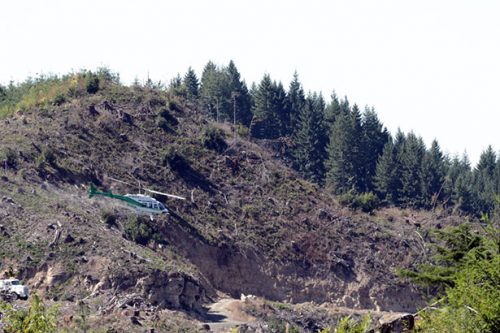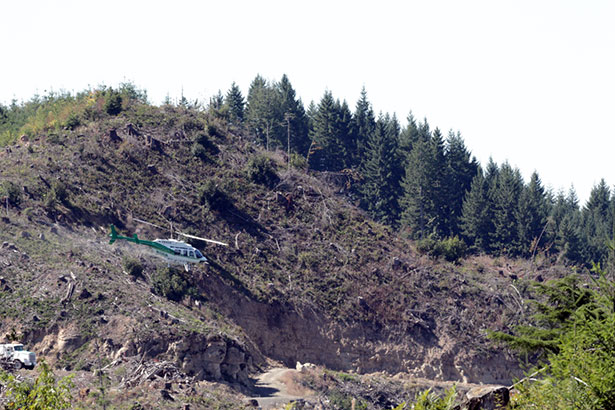
 |
| Photo by Gary Hale / Forestland Dwellers |
Jenn Ruppert had just dropped her kids off at school when she noticed the aerial spray of chemicals drifting down from an application just over 2 miles from Triangle Lake Charter School. She says she could smell the spray when she returned with her husband to retrieve her two daughters and let the school know about what was going on.
It was 8 am on the first day of classes, and a private timber company was spraying pesticides that were allegedly drifting onto nearby properties and onto the school itself.
The Hwy. 36 community and the Triangle Lake area are no strangers to the issue of aerial pesticide sprays. Organic farms and homes are bordered by industrial timberlands, and residents have long complained about the effects of the pesticides used on clearcuts. This latest spray once again calls attention to what critics see as a flawed system of dealing with pesticides on private timberlands.
After years of complaints, the Oregon Health Authority conducted the Highway 36 Exposure Investigation, which found that residents in the area had been exposed to the chemicals atrazine and 2,4-D, according to a 2013 public health assessment.
The Ruppert farm is a 1-mile drive from the school, a third of a mile as the crow flies, and Ruppert says she could smell the chemicals at her home as well. She says she and her children felt the effects of exposure to what was sprayed — nausea, burning eyes, shaking.
Gary Hale of Forestland Dwellers also observed and videoed the spray. Hale and his wife, Jan Wroncy, subscribe to the spray notifications from the Oregon Department of Forestry (ODF) and supply notifications to EW, but he points out it is a paid subscription and unless you subscribe, residents will not be told an aerial spray is happening. The window can be several months long and up to a year, so even subscribers won’t know exactly when a spray will happen until they see the helicopter or plane overhead.
Hale says, “If they are not going to have a large buffer around school, at least 3 to 5 miles, then schools should be notified,” because while the spray notices are vague about the time and dates of sprays, they do list what chemicals might be sprayed. Without notifications, Hale says, if a kid is sick and goes to the doctor, the doctor won’t know what could have been used.
The spray notice Weyerhaeuser filed with the Oregon Department of Forestry (ODF) says possible chemicals used were aminopyralid, metsulfuron methyl, glyphosate, imazapyr and sulfometuron methyl. The noticed was submitted on Aug. 12, and the spray was slated to occur any time between Sept. 2 and Dec. 31. The areas were sprayed Sept. 8 and 9.
Lisa Arkin of Beyond Toxics, who went out to look at the area last week, says the buffer the Oregon Legislature voted give to school kids this year is 60 feet — the same it gives fish-bearing streams. She points out that the 60-foot measurement is from the buildings, not from the playground or other outdoor areas.
Arkin says, “In a community where there has been so much about aerial sprays and harm, Weyerhaeuser chose to spray all over the valley, close to the school on the first two days of school.” She says the Oregon Department of Agriculture (ODA) tells her there were at least 10 sprays the first day.
Ruppert reported the sprays and symptoms, and Bruce Pokarney of the ODA confirms that ODA inspectors have been to the Ruppert property and the school, “and have taken environmental samples (plants) from both locations. They are currently in the lab for analysis.” He says, “I don’t know yet when we will have results.”
Weyerhaeuser spokesman Greg Miller says, “We are aware of the complaint filed with Oregon Department of Agriculture. We will cooperate with ODA as it proceeds through its complaint process. We follow all state and federal laws when we apply forest herbicides.”
Ruppert has contacted the Triangle Lake school repeatedly, she says, and asked that information be provided to parents about their children’s possible exposure, but she says that has not happened.
School principal and superintendent James Brookins says that Triangle Lake was not notified of the spray because it is not on ODF’s list, but will be “potentially pursuing receiving” spray notifications, adding, if the spray notices “were to come out without prompting that would be wonderful.”
He adds that as a charter school, Triangle Lake’s focus areas are “health and wellness, technology and natural resources so we are, as an institution, concerned with these issues.”
Ruppert says she too is concerned — both for her family and for the school — because Weyerhaeuser has been clearcutting around her property, and she worries about what will happen when the company begins to spray even closer to her home and the school. — Camilla Mortensen
The Ruppert family at their farm. Photo by Beyond Toxics